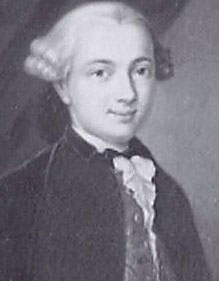Joseph Gaertner facts for kids
Quick facts for kids
Joseph Gaertner
|
|
|---|---|
 |
|
| Born | 12 March 1732 Calw, Baden-Württemberg, Germany
|
| Died | 14 July 1791 (aged 59) Tübingen, Germany
|
| Education | University of Göttingen |
| Known for | Work on seeds, De Fructibus et Seminibus Plantarum |
| Scientific career | |
| Fields | Botany |
| Institutions | University of Tübingen, University of St Petersburg |
| Academic advisors | Albrecht von Haller |
| Author abbrev. (botany) | Gaertn. |
Joseph Gaertner (born March 12, 1732 – died July 14, 1791) was a German botanist. He is most famous for his important work on seeds. This work was called De Fructibus et Seminibus Plantarum. It was published between 1788 and 1792.
Early Life and Studies
Joseph Gaertner was born in Calw, Germany. He studied at the University of Göttingen. There, he learned from a famous scientist named Albrecht von Haller.
Gaertner was mainly interested in nature. He also studied physics and zoology. He traveled a lot to meet other scientists.
His Work as a Professor
In 1760, Gaertner became a professor of anatomy in Tübingen. Later, in 1768, he was made a professor of botany in St Petersburg. He returned to Calw in 1770.
Gaertner studied how traits are passed down in plants. He noticed that some traits were stronger than others. He also saw that male and female plants contributed equally to their offspring.
He observed that the first generation of plants looked very similar. But the second generation showed many differences. Some plants even had new traits. Gaertner's observations were important. They helped set the stage for later discoveries by Gregor Mendel.
De Fructibus: A Book on Seeds
By 1770, Joseph Gaertner had started writing his big book. It was called De Fructibus et Seminibus Plantarum. He spent almost all his time on this project. He studied so much that he almost became blind. He used a microscope for many of his studies.
This book had very detailed descriptions. It covered over a thousand different plant species. It changed how people studied plant parts. The book also included 180 detailed pictures. These pictures were made from copper plates.
Legacy
The genus of plants called Gaertnera was named after him. These plants belong to the Rubiaceae family.

